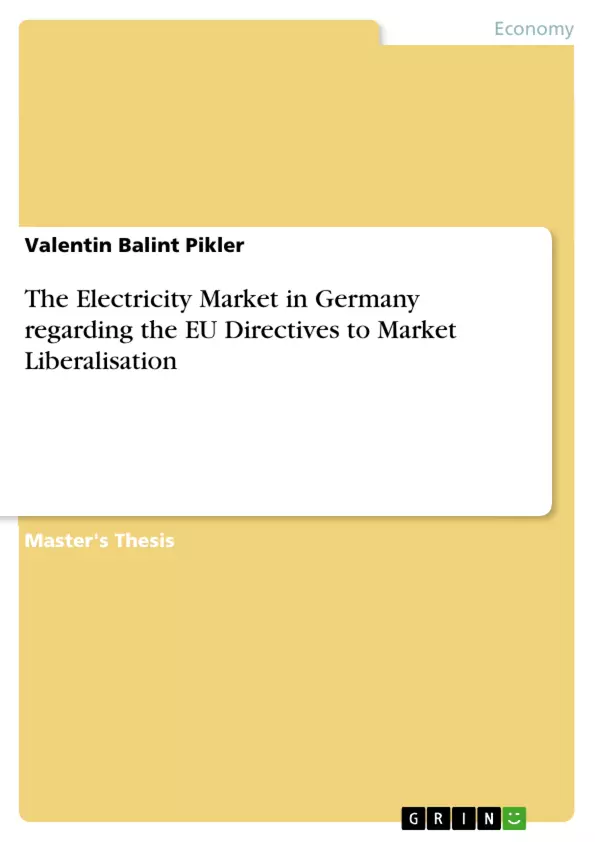The main understanding of this work will suggest that the electricity market liberalisation need a new impulse from the biggest market players and from the regulators. The liberalisation process is defaulting; the practice and implementation should more precedes as the electricity market in the EU. The base; the Directives are settled by the Commission. The implementation by the big four companies on the market is be a long time coming. There is a wide range of different national experiences of liberalisation electricity markets in terms of the degree of the concentration of generation, the stringency of unbundling public ownership and regulatory institutions. The thesis is combining the “Third Party Access” and the “Single Buyer Model” with its empirical evidence and their implementation for Germany. However, the results of this report will reach a number of significant conclusions at the end of the thesis and will make several policy recommendations. (Blaxter,2006). It draws a distinction between observations that are relevant to the design a well functioned electricity markets. The German electricity sector has undergone considerable changes throughout the past few years (RWE, 2007). Main developments were related to liberalisation of electricity markets (generation and sell of power) and transport of electricity (grid operations), the evolving European CO2 emissions trading scheme and the promotion of renewable electricity generation.
Inhaltsverzeichnis (Table of Contents)
- 1. Introduction
- 2. Theory of the electricity and the electrical energy industry
- 2.1 Introduction to the electricity itself.
- 2.2 Introduction into the electricity market mechanism
- 2.3 Electricity market function
- 2.4 The European electricity market
- 2.5 The Germany market.
- 2.6 The German power exchange.......
- 2.7 The working principles of the EEX
- 2.8 The German market structure at the beginning of the liberalisation
- 3. The liberalisation
- 3.1 The history of liberalisation
- 3.2 The process of the Liberalisation in the EU and the German implementation
- 4. First period the energy trade liberalisation the EU Directives
- 4.1 The first Directive
- 4.2 The summary of the legislative regulations....
- 4.3 The electricity prices and the dilemma between liberalisation and price spoiling on the German market.
- 4.4 Reserve and balancing power market..
- 5. Second period of the energy trade liberalisation
- 5.1 The second Electricity Directive.
- 5.2 The cross-border regulation ......
- 5.3 The security of supply ......
- 6. The characteristic of the liberalised electricity market .......
- 6.1 Interview and survey: some questions to my colleagues and their comments to the liberalisation.
- 6.1.1 What are the price differences between Germany and the other EU states (X-Border trading).....
- 6.1.2 Why not propose to control prices? .....
- 6.1.3 Trading: why are the electricity prices so high? .......
- 6.2 Single market issue, is it something useful?
- 7. Electricity trading principles
- 7.1 Trading.....
- 7.1.1 The early trading experiences
- 7.2 The Models of the liberalised electricity trading
- 7.2.1 To the TPA and the \"single-buyer\" model..............
- 7.3 The single buyer model in detail
- 7.3.1 The strong liberal model
- 8. Modelling of the competition in the electricity market ....
- 8.1 The grid access model
- 9. Approach adopted ......
- 9.1 Methods
- 9.2 Research Strategy.
- 9.3 Sampling.
Zielsetzung und Themenschwerpunkte (Objectives and Key Themes)
This dissertation aims to analyze the electricity market liberalization in Germany within the framework of EU directives. It explores the history, implementation, and current state of the German electricity market, specifically examining the impact of EU directives on its structure and performance. Key themes include:- The evolution of the German electricity market under EU liberalization policies
- The impact of EU directives on market structure and competition
- The role of price dynamics and balancing mechanisms in the liberalized electricity market
- The effectiveness of various electricity trading models, including the TPA and single-buyer models
- The challenges and opportunities associated with ensuring security of supply in a liberalised electricity market
Zusammenfassung der Kapitel (Chapter Summaries)
Chapter 1 introduces the topic of electricity market liberalization in Germany and outlines the research objectives. Chapter 2 provides a theoretical background, discussing the fundamentals of the electricity industry, its market mechanism, and the structure of the European and German electricity markets.
Chapter 3 explores the history and process of liberalization in the EU, focusing on the German implementation. Chapter 4 analyzes the first phase of EU energy trade liberalization, examining the first directive, its legislative regulations, the impact on electricity prices in Germany, and the role of reserve and balancing power markets.
Chapter 5 examines the second phase of energy trade liberalization, analyzing the second Electricity Directive, its cross-border regulations, and the challenges of ensuring security of supply. Chapter 6 investigates the characteristics of the liberalised electricity market in Germany, analyzing the price differences between Germany and other EU countries, the potential for price control, and the impact of trading on electricity prices.
Chapter 7 delves into electricity trading principles, exploring the early trading experiences, the different models of liberalised electricity trading, and the details of the single-buyer model. Chapter 8 examines the modelling of competition in the electricity market, specifically focusing on the grid access model.
Chapter 9 outlines the research methodology, including the methods used, the research strategy, and the sampling procedures.
Schlüsselwörter (Keywords)
This dissertation explores the German electricity market, focusing on the liberalization process driven by EU directives. Key terms include: electricity market liberalization, EU directives, German electricity market, energy trade, price dynamics, balancing mechanisms, trading models, TPA, single-buyer model, security of supply, grid access, and competition. The work draws insights from empirical evidence, historical analysis, and interviews with industry experts.- Quote paper
- Valentin Balint Pikler (Author), 2010, The Electricity Market in Germany regarding the EU Directives to Market Liberalisation, Munich, GRIN Verlag, https://www.grin.com/document/152291



